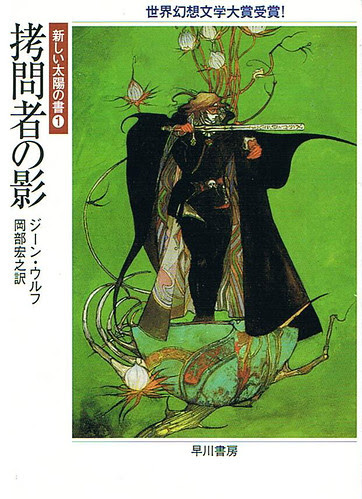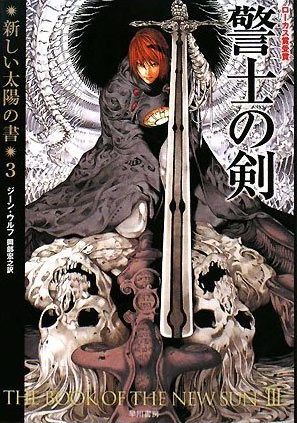For the past several months, my fun pitch for The Book of the New Sun has been: it’s a science fiction novel where the narrator thinks he’s in a fantasy novel. Severian’s describing his matachin tower Citadel and you’re ho-humming along, and then suddenly he brings up how the bottom of it is a propulsion chamber and you realize it’s a goddamned rocket ship. In the first chapter, he sees a man shoot an evil green light and refers to it first as a “radiant wand” before realizing it’s a laser gun. Severian wields a big sword and rides around on mutant horses called destriers. Yet paying close enough attention reveals that the portrait of the gold-helmeted man he finds in the guild library is a photo of the Apollo 11 moon landing. Now that I’ve finished reading these books, I’d like to offer some more organized thoughts.
This spring, I started skimming science fiction literature. My own creative work has been headed in that direction for some time – still a little early to share the fruits of that labor – and I found comfort in reading the work of those who made historical marks in the community, landmarks that themselves created their own subgenres. I read Dick’s The Man in the High Castle, Gibson’s Neuromancer, McCarthy’s The Road, and the first couple books of King’s Dark Tower in short succession, and took my first step into Pratchett’s Discworld with Monstrous Regiment. These were all books that loomed over the entire science fiction genre – their influence and popularity is regularly cited for inspiration and personal recommendation alike. I enjoyed each one of them, which I think are varying degrees of entertaining and profound. But also, sometimes it’s just enough to have lobster-monsters go “dod-a-chick?” and have them walk after your characters.
Until a podcast by a few critics I like picked up Gene Wolfe’s Book of the New Sun, I’d never heard of the saga or Wolfe himself. No one I’ve had a conversation with knows these books either, which surprises me only a little. You can find quotes from Le Guin, Ellison, Disch, and Gaiman all declaring Wolfe a master of fantasy fiction. You can find them calling him “a modern-day Melville,” “the greatest writer in the English language today,” Proust meets Beethoven, and Wolfe’s prose holds up to the highest scrutiny. It is gorgeous, thoughtful, musical work, and it works equally well for action and introspection. But these books are an odd, challenging read with a genuinely craven protagonist, and I think it’s telling that the highest acclaim I can find for these books is in deep genre spaces or on 4chan’s greatest books of all time.
The Book of the New Sun is quickly described as a science fiction/fantasy saga of four books written by an engineer and Catholic convert reckoning with the more grotesque mythology of scripture and its exegesis. On a dying Earth (“Urth”), a boy named Severian is raised by a guild of imperial torturers in service of a divine ruling Autarch – when Severian betrays this guild’s laws, he is exiled and set on an adventure that will put him directly at the center of Urth’s fate. While our narrator Severian claims that his betrayal was that he “showed mercy to a woman he loved,” this is one of the many half-truths Severian will offer us.
Before I get into the mess of Severian, I’ll introduce the mostly delightful cast of characters Severian meets, and the pulpy thrill of the adventures he gets into. There’s the traveling actors Dr. Talos and Baldanders, who at first seem to be a match for The Princess Bride’s Vizzini and Fezzik, that rope Severian into a 16th century morality play. For a time, Severian travels with a veteran sailor named Jonas, who has a nonstop bucket of bizarre aphorisms and a knowledge of spacefaring monsters like the hydra-bat notules. He travels from time-traveling greenhouses to underground cities of man-apes, fights a Monster Manual of fire-breathing salamanders whose heads bloom like a flower right before they unleash their scorching torrent, meets aliens in masks and witches in rituals. In the second book, I think he gets ambushed six times, mostly because he’s so lost in the sauce of his philosophizing that he simply fails to pay attention to his surroundings.

Runs in the second and third book fly by where a full two hundred pages are made up of rip-roaring good times. Many of the coolest fantasy ideas I’ve ever read occur over a single chapter, and while Severian reflects on them, it’s on to the next leg of the adventure. The book takes us from garden parties to daring escapes to monsters and monarchs without any room to breathe – even within the picaresque novel formula, there’s significantly less quiet between moments of serious impact and importance. There’s a lot of incident in these books, and very little of it isn’t reflected on by our narrator. Severian repeatedly reminds us that he has a “perfect memory,” except for all the times he doesn’t and all the times he isn’t paying attention because he’s too busy thinking about how badly he’d like to sleep with just about any woman in front of him.
I enjoy a story about a freaky little creep. There are times where Severian pushes the boundaries of that, either because he’s so casual about it (maybe never moreso than sexual violence he commits in the second book) or because some of his longer digressions point toward conclusions I find distasteful. Especially in the third and fourth novels, Wolfe advances a form of Christian Science through Severian’s musing, working to reconcile his own (self-described) “rational” beliefs with the beliefs of his Catholic wife. It advances arguments against “science gone awry” with panicked allegories to plastic surgery, cloning and genetic modification, and argues that ungoverned science will lead to moral degradation.

Severian’s value system is entirely warped by an institution which has made him monstrous, and he will go on to be a murderer, executioner, rapist, bigot, serial traitor, and self-mythologizing oblivious teenager. However, our narrator is loquacious, introspective, philosophical, and significantly more attentive to the emotions others experience than the character we see Severian to be in his actions with other people. As we keep reading, we come to understand how he has changed so dramatically in what he repeatedly reminds us is only a matter of months – the majority of the story’s action, barring the first eight or so chapters which loosely flit between the beginning of the story and Severian’s boyhood prior, occurs over the span of roughly a single year.
There are direct and indirect references to the life of Christ and The Confessions of St. Augustine throughout, as well as attempts to reconcile more literal exegetical readings of Catholic literature and sacrament. While Severian’s own life, as he tells it, resembles many incidents in the life of Christ, I would not go so far as to say he is meant as a Christ figure himself, but a study of how even the cruelest and most selfish of young men, raised in a world built to prevent him the path to righteousness, might become at least a more complicated man. I was not raised Catholic and likely miss a good amount of the philosophy and scripture Wolfe is working through, though I do know some of Augustine. Severian is not nearly so penitent for his evils. He tells them very plainly, without beseeching a higher power to cleanse him of sin, and often offers excuses and justifications for his actions. Alongside them, he tries to find meaning in it all.
It’s in this balance that The Book of the New Sun finds itself a gripping read. It has serious ideas written about seriously, but also wants to make sure it has room for a little green man from the future who’s scamming people with false prophecy. Not all of those serious ideas are agreeable, tastefully explored, or especially profound, but the combination with pulp adventure and the quality of Gene’s writing is hard to match. Both in terms of philosophical thinking and just pure cool fantasy storytelling, many of the people who love these books basically never stop reading them. If you read these books on my behalf, I’ll be so excited to talk about them with you – for now, I’m taking a break from genre fiction with Lawrence’s The Rainbow.
I’ll leave with a passage from The Shadow of the Torturer’s first chapter, for my money the most beautiful individual moment in these four novels. These words tipped me full tilt into the world of Wolfe, and I hope reading them intrigues one person enough to tip them into Urth’s orbit.
“We believe that we invent symbols. The truth is that they invent us; we are their creatures, shaped by their hard, defining edges. When soldiers take their oath they are given a coin, an asimi stamped with the profile of the Autarch. Their acceptance of that coin is their acceptance of the special duties and burdens of military life – they are soldiers from that moment, though they may know nothing of the management of arms. I did not know that then, but it is a profound mistake to believe that we must know of such things to be influenced by them, and in fact to believe so is to believe in the most debased and superstitious kind of magic. The would-be sorcerer alone has faith in the efficacy of pure knowledge; rational people know that things act of themselves or not at all.”


